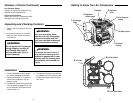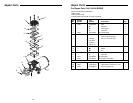
9
Thermal Overload Protector
If thermal overload protector shuts motor
OFF frequently look for the following
causes.
1. Low voltage.
2. Wrong gauge wire.
3. Clogged air filter.
4. Lack of proper ventilation.
5. Unit is being used with an extension
cord.
See Troubleshooting Chart for corrective
action.
This compressor is equipped
with an automatic reset thermal
overload protector which will
shut off motor if it becomes
overheated.
!
CAUTION:
The motor must be allowed to
cool down before start-up is
possible. The motor will auto-
matically restart without warn-
ing if left plugged into electrical
outlet, and the motor is turned
on.
!
CAUTION:
ASME Safety Valve
A safety valve that automatically releases
the air if the air receiver (tank) pressure
exceeds the preset maximum.
PSI (Pounds per Square Inch)
Measurement of the pressure exerted by
the force of the air. The actual psi output
is measured by a pressure gauge on the
compressor
SCFM (Standard Cubic Feet per
Minute)
Sometimes called CFM (Cubic Feet per
Minute). Measurement of air volume
delivered by the compressor.
Air Delivery
A combination of psi and SCFM. The air
delivery required by a tool is stated as
(number) SCFM at (number) psi. The
combination of these figures determines
what size unit is needed.
Air Tank Capacity
The volume of air stored in the tank and
available for immediate use. A large tank
allows the intermittent use of an air tool
with an air requirement higher than the
compressor’s rated delivery.
Volts or Voltage
A measurement of the force of an electri-
cal current.
Amps or Amperage
A measure of the electrical force minus
the resistance on an electrical line.
Ridgid air compressors require 15 amps
for operation. Be sure the compressor
will operate on an electrical line with the
proper amps. If other appliances operate
on the same line, they will reduce the
available amps. If the amperage is not
adequate, the result will be blown fuses
or tripped circuits.
Regulator
A control that adjusts the line pressure to
the proper amount needed to operate
spray guns and air tools.
Tanks Pressure Gauge
Indicates tank pressure in psi.
Glossary of Terms
8
The plug supplied on your tool may not
fit into the outlet you are planning to use.
Your local electrical code may require
slightly different power cord plug connec-
tions. If these differences exist refer to
and make the proper adjustments per
you local code before your tool is
plugged in and turned on.
In the event of a malfunction or break-
down, grounding provides a path of least
resistance for electrical current to reduce
the risk of electric shock. This tool is
equipped with an electric cord having an
equipment-grounding conductor and a
grounding plug, as shown. The plug must
be plugged into a matching outlet that is
properly installed and grounded in accor-
dance with all local codes and ordi-
nances.
Do not modify the plug provided. If it will
not fit the outlet, have the proper outlet
installed by a qualified electrician.
Improper connection of the equipment-
grounding conductor can result in a risk
of electric shock. The conductor with
insulation having an outer surface that is
green with or without yellow stripes is the
equipment-grounding conductor. If repair
or replacement of the electric cord or
plug is necessary, do not connect the
equipment-grounding conductor to a live
terminal.
If the grounding instructions are not com-
pletely understood, or if you are in doubt
as to whether the tool is properly ground-
ed check with a qualified electrician or
service personnel.
Motor Specifications and
Electrical Requirements (continued)
110-120 volt, 60Hz Tool Information
If not properly grounded, this
tool can cause an electrical
shock, particularly when used
in damp locations, in proximity
of plumbing, or out of doors.
!
WARNING:
TEST
RESET
Grounding Prong
3-Prong Plug
Properly
Grounded
3-Prong
Outlet
Extension Cords
1. The air compressor should be located
where it can be directly plugged into
an outlet. An extension cord should
not be used with this unit.
2. To avoid loss of power and overheat-
ing, additional air hose must be used
to reach work area instead of exten-
sion cords.















